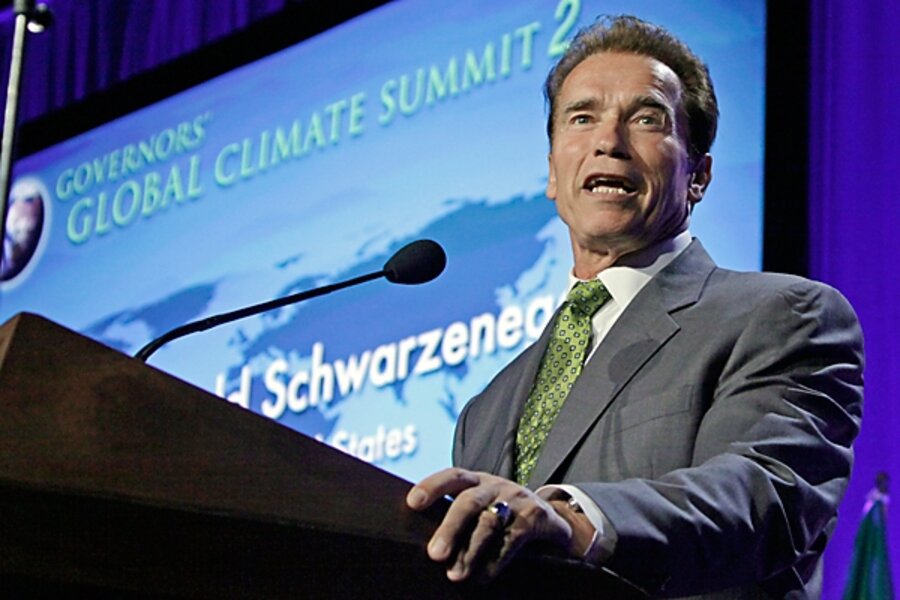Schwarzenegger leads governors' summit on global warming
| Los Angeles
Some 1,200 representatives from more than 70 states, provinces, and countries are meeting here this week for California Gov. Arnold Schwarzenegger’s Global Climate Summit 2.
Three years after Governor Schwarzenegger won global attention for signing legislation committing the world’s eighth largest economy to reduce its greenhouse gases 25 percent by 2020, the gathering is trying to pave the way for a United Nations conference in Copenhagen, Demark, in December to establish new, worldwide emissions targets.
The goal is to provide leaders below the national level the opportunity to influence the position of their national governments in advance of the Copenhagen summit.
Experts estimate that 50 to 80 percent of actions needed to reach the UN climate goals will be implemented at the state and local levels.
Participants are engaging in 21 panels featuring discussions on energy efficiency, low-carbon fuels, green buildings, clean technology, job creation, water management, deforestation, sustainable development, training opportunities, and adaptation strategies.
Interviews with key attendees show that California’s example continues to pave the way. As one of the world's largest economies, California has key economic and environmental interest in the progress and design of any international agreement to reduce greenhouse-gas emissions.
More than 30 US states have followed the California example with climate action plans, and “even more are copying it,” said Terry Tamminen, former secretary of the California Environmental Protection Agency and now senior fellow for climate policy at the New America Foundation. Those include provinces in Canada, states in Mexico, and regions in places like Brazil and Indonesia.
Schwarzenegger’s California summit is another way for others to see what to do and follow suit, says Mr. Tamminen, “because if all these nations get to Copenhagen with the feeling that they are starting over, we will fail.”
"We realize that national governments are a little slow in getting to work on this problem,” he said.
Many cities are trying to reduce the amount of driving – probably the biggest growth area for emissions – says Mary Nichols, chairman of California’s Air Resources Board (CARB), in an interview. One is a plan adopted by Mexico City to commit to 5 percent of its traffic being bicycles.
"This is one of the most congested cities in the world, and they are actually doing it,” Ms. Nichols says.
"California is an example of what can be done,” said John Wiebe, president and CEO of the Globe Foundation in Vancouver, British Columbia, a company which works with private companies to turn environmental problems into business opportunities. “Even if we can’t do as much as we want in recessionary times, it’s important to keep talking like this, because it moves the ball forward.”
Geert Criles, consulate general of Belgium, says Schwarzenegger’s example is helping to spotlight the fact that work on climate change doesn’t only happen from the national government down. “Several regions and provinces are seeing here how they can contribute from the bottom up,” says Mr. Criles.
Schwarzenegger and California’s climate initiatives get credit for keeping the pressure on the federal government to act.
Before he took office after the election, then President-elect Obama said, “When I am president, any governor who’s willing to promote clean energy will have a partner in the White House.”
The US governors who are co-hosting and attending the summit here are Jennifer Granholm of Michigan, David Paterson of New York, Ted Kulongoski of Oregon, Chris Gregoire of Washington, and Jim Doyle of Wisconsin.
Today, Schwarzenegger issued the following statement after Sens. Barbara Boxer (D) of California and John Kerry (D) of Massachusetts introduced federal climate change legislation:
"I applaud Senators Boxer and Kerry for introducing climate change legislation that builds on many of California’s first-in-the-nation policies, including our aggressive cap on global warming pollution, complementary emissions standards, and our innovative plan to reduce emissions by curbing sprawl.”
-----
Follow us on Twitter.





